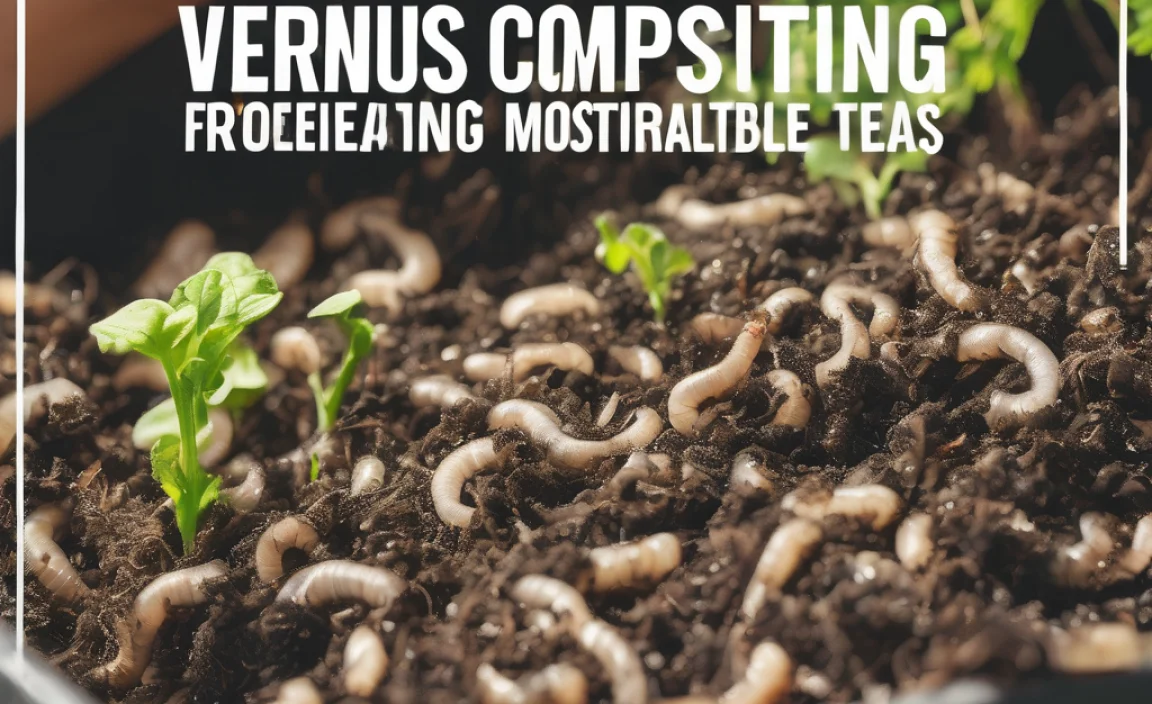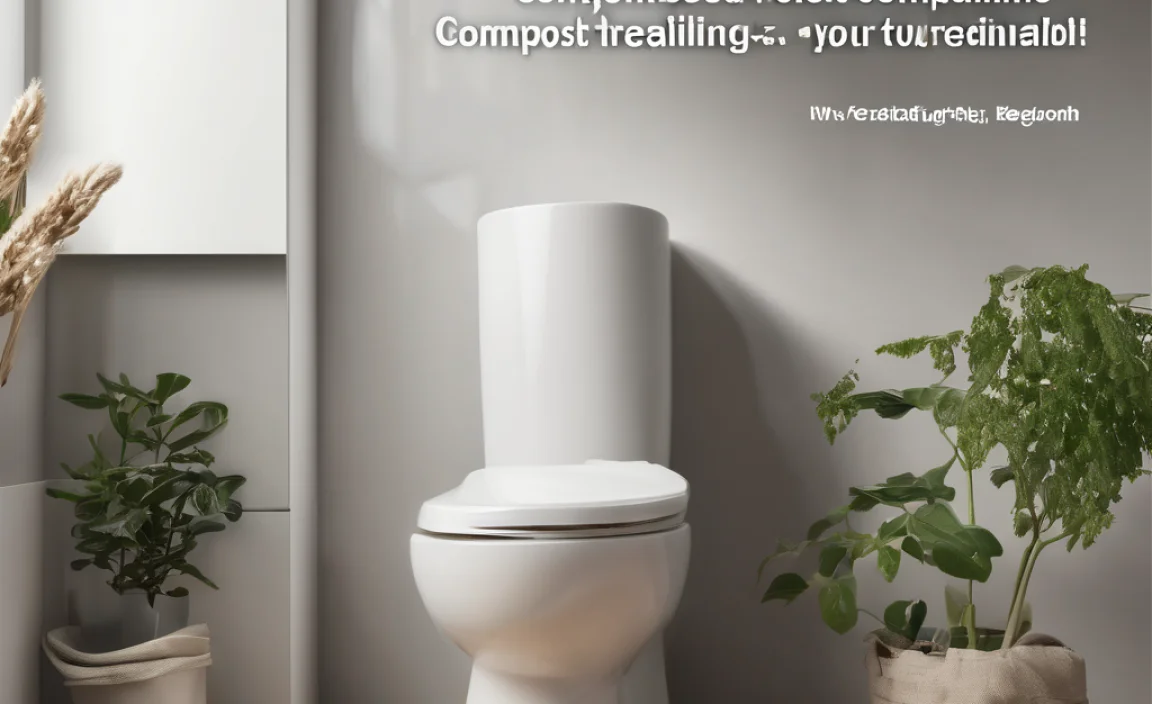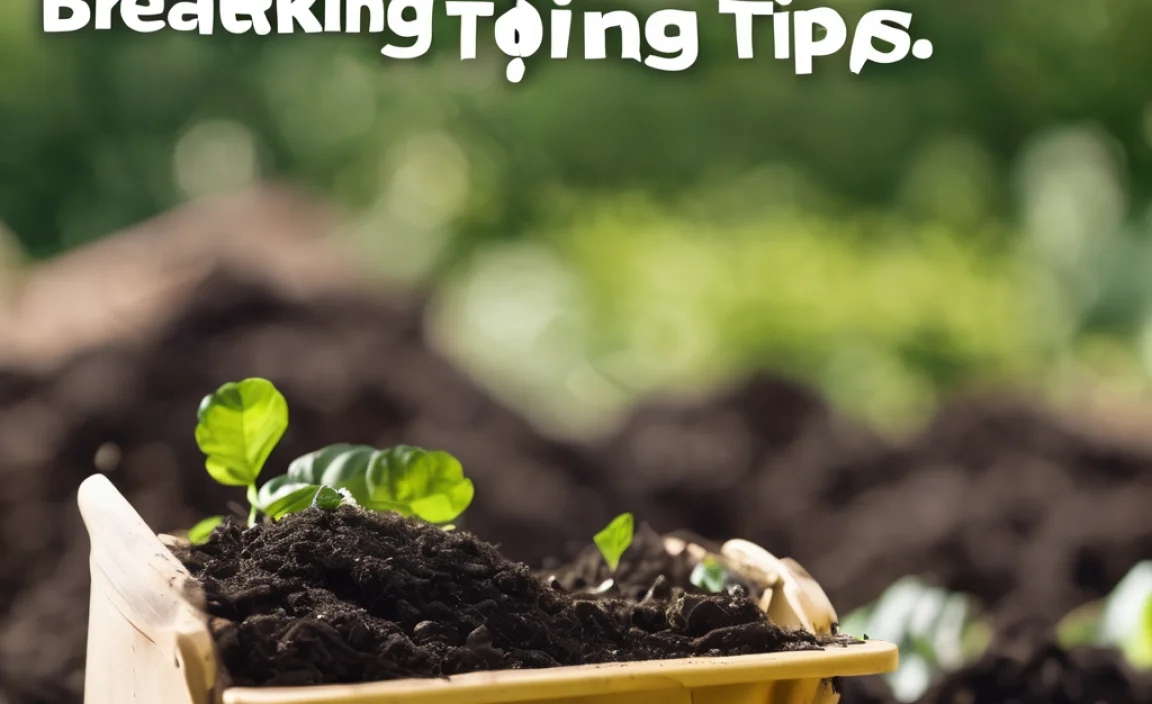Ever looked at your garden and wished it had that extra pop? That lush green that just screams healthy? Sometimes, the secret isn’t fancy fertilizers. It’s something much simpler and way more natural: compost. If you’re new to gardening, the idea of making your own soil booster might sound a bit tricky. But trust me, it’s easier than you think! We’ll break down exactly why compost is a garden superhero. Stick around, and you’ll be turning kitchen scraps into garden gold in no time!
Compost Soil Benefits: Essential Garden Gains
Hey there, fellow gardeners and DIY enthusiasts! Troy D Harn here from TopChooser. You know, I’ve always believed that the best results often come from nature’s own solutions. And when it comes to giving your garden a serious upgrade, there’s nothing quite like compost. It’s like a superfood for your soil! Many people think gardening is all about planting and watering, but the real foundation of a thriving garden is healthy soil. And that’s where compost truly shines.
We’re going to dive deep into why adding compost to your garden is one of the smartest moves you can make. It’s not just about giving your plants a little something extra; it’s about creating a balanced, living ecosystem right under your feet. Think of it as giving your soil a rich, nutritious meal that keeps on giving. We’ll cover everything from how it improves your soil’s structure to how it helps plants fight off diseases. By the end of this, you’ll be a compost convert, ready to reap all the wonderful rewards.
What Exactly is Compost Soil?
Before we get into the amazing benefits, let’s quickly touch on what we mean by ‘compost soil.’ It’s not a specific type of soil you buy off the shelf. Instead, compost is a nutrient-rich material created from the decomposition of organic matter. Think of your kitchen scraps (like fruit and vegetable peels, coffee grounds, and eggshells) and yard waste (like leaves, grass clippings, and small twigs). When these organic materials are broken down by microorganisms, like bacteria and fungi, they transform into a dark, crumbly, soil-like substance. This is compost!
When we talk about ‘compost soil,’ we often mean either pure, finished compost used as a soil amendment or a garden soil mix that has a significant amount of compost blended into it. Regardless, the magic comes from the compost itself. It’s essentially nature’s recycled fertilizer, bringing life and nourishment back to the earth.
The Incredible Compost Soil Benefits You Simply Can’t Ignore
Adding compost to your garden isn’t just a good idea; it’s essential for a truly flourishing outdoor space. It’s a powerhouse of benefits that impacts everything from the physical structure of your soil to the health and vitality of your plants. Let’s break down these garden gains:
1. Supercharges Soil Structure and Aeration
One of the most immediate and impactful compost soil benefits is its ability to dramatically improve soil structure. Have you ever dealt with soil that’s like thick clay, hard as a rock when dry, and like sticky mud when wet? Or maybe soil that’s so sandy it drains away instantly, taking all the nutrients with it?
- For Clay Soils: Compost acts like a natural conditioner. It helps to bind small clay particles together, creating larger clumps called aggregates. This process loosens the soil, allowing for better air and water penetration. Your plants’ roots will thank you for the breathing room!
- For Sandy Soils: Compost has a sponge-like quality. It helps sandy soils retain moisture and nutrients by acting as a binder. Instead of water and nutrients just washing straight through, they are held in the soil where your plants can access them.
- Overall Texture: Whether your soil is heavy clay or light sand, compost makes it more crumbly, workable, and easier for plant roots to penetrate. This improved aeration also helps beneficial microbes thrive.
2. Boosts Nutrient Content and Availability
Compost is packed with essential nutrients that plants need to grow strong and healthy. While it might not have the sheer N-P-K (Nitrogen-Phosphorus-Potassium) numbers that chemical fertilizers boast, it delivers these nutrients in a slow-release, natural form.
- Slow-Release Feeding: Unlike synthetic fertilizers, which can give plants a quick shot of nutrients that can be washed away by rain or irrigation, compost releases its nutrients gradually over time. This provides a steady food source for your plants and reduces the risk of “burning” them with an overdose.
- Micronutrients Galore: Beyond the main N-P-K, compost contains a wide array of essential micronutrients (like iron, manganese, zinc, and copper) that are crucial for plant health and development. These are often lacking in depleted soils.
- Improved Nutrient Uptake: Compost doesn’t just add nutrients; it also helps plants absorb them more effectively. The rich organic matter stimulates beneficial microbial activity, which plays a key role in making soil nutrients available to plant roots.
3. Enhances Water Retention and Drainage
This might seem like a contradiction, but compost is a champion at balancing both water retention and drainage. It’s all about its incredible physical properties.
- Holds onto Water: The organic matter in compost acts like a sponge. It can absorb and hold onto water, making it available to plants during dry spells. This can significantly reduce the need for frequent watering, saving you time and water.
- Improves Drainage: While it holds water, compost also creates tiny air pockets within the soil. This prevents water from becoming stagnant, which is crucial for root health. Waterlogged soil can suffocate roots and promote disease.
4. Promotes Healthy Microbial Activity
Healthy soil is a living ecosystem, teeming with billions of microorganisms. Compost is the fuel that feeds these beneficial microbes, fungi, and earthworms. This microbial life is the powerhouse behind many of the other compost soil benefits.
- Natural Fertilizers: Many microbes in the soil are responsible for breaking down organic matter and making nutrients available to plants.
- Disease Suppression: A robust community of beneficial microbes can actually help to suppress soil-borne diseases and pests. They can outcompete harmful organisms or even produce compounds that deter them. This is a key reason why compost is often called nature’s pesticide and fungicide.
- Earthworm Food: Earthworms absolutely love compost! They burrow through the soil, further aerating it and mixing in valuable organic matter, creating those desirable ‘soil aggregates’ we talked about.
5. Helps Plants Resist Pests and Diseases
As mentioned above, a healthy soil microbiome fueled by compost is a powerful defense system for your plants.
- Stronger Plants: Plants grown in compost-rich soil are generally healthier and more vigorous. Stronger plants have a better natural ability to fend off pests and diseases.
- Beneficial Microbes: A diverse community of beneficial microorganisms actively competes with or directly attacks harmful pathogens in the soil. This means less reliance on chemical treatments.
- Improved Root Health: Healthy roots are less susceptible to root rot and other diseases. Compost’s ability to improve drainage and aeration contributes significantly to robust root systems.
6. Balances Soil pH
Soil pH is a measure of how acidic or alkaline your soil is. Most plants prefer a slightly acidic to neutral pH range (around 6.0 to 7.0). If your soil is too acidic or too alkaline, plants can struggle to absorb essential nutrients, even if they are present.
- Buffering Effect: Compost acts as a natural buffer, helping to stabilize soil pH. If your soil is too acidic, compost can help raise the pH. If it’s too alkaline, compost can help lower it.
- Increased Nutrient Availability: By bringing the pH closer to the ideal range for most plants, compost helps unlock nutrients for easier plant uptake.
7. Reduces the Need for Chemical Fertilizers and Pesticides
This is a big one for both your wallet and the environment. By feeding your soil with compost, you’re creating a self-sustaining system that requires fewer artificial inputs.
- Less Financial Outlay: You’ll find yourself buying fewer bags of expensive fertilizers and potentially less need for chemical pest and disease control.
- Environmental Friendliness: Reduced reliance on chemical inputs means less potential for runoff into waterways and less harm to beneficial insects and wildlife. It’s a greener way to garden!
8. Eco-Friendly Waste Management
Composting is a fantastic way to reduce the amount of waste you send to landfills. Kitchen scraps and yard waste make up a significant portion of household garbage. By composting them, you’re diverting this organic material and turning it into a valuable resource.
- Reduces Landfill Waste: Less waste in landfills means less methane gas produced (a potent greenhouse gas) and a longer lifespan for our landfill sites.
- Circular Economy: Composting is a perfect example of a circular economy – turning waste into a product that benefits your home and garden.
How Compost Contributes to Your Garden’s Visual Appeal
Beyond the soil science, compost directly contributes to a more beautiful and productive garden:
- Healthier, Greener Foliage: Plants that receive consistent nourishment from compost have richer, greener leaves.
- More Abundant Blooms and Fruits: Well-fed plants are more likely to produce flowers and fruit. The balanced nutrients in compost support the entire plant lifecycle.
- Increased Plant Vigor: You’ll notice your plants looking more robust and less stressed, even in challenging weather conditions.
When to Add Compost to Your Garden
You can add compost to your garden at several key times:
- As a Soil Amendment: This is the most common time. Dig compost into your garden beds before planting new flowers, vegetables, or shrubs. It improves the soil structure and enriches it for the upcoming growing season.
- Top Dressing: Spread a layer of compost around existing plants. This is especially helpful in mid-season when plants might need a nutrient boost or during dry periods to help retain moisture.
- When Planting Transplants: Mix a bit of compost into the planting hole when you’re transplanting seedlings or young plants. This gives them a great start in their new location.
- Around Established Trees and Shrubs: Apply a layer of compost evenly around the base of trees and shrubs, extending out to the drip line (the edge of the canopy). Avoid piling it directly against the trunk.
How Much Compost Should You Use?
The amount of compost to use can vary depending on your soil type and what you’re planting, but here’s a general guideline for beginners:
- Garden Beds: Aim to incorporate 2-4 inches of compost into the top 6-8 inches of soil before planting.
- Established Flower Beds: Apply a 1-2 inch layer as a top dressing in spring and fall.
- Vegetable Gardens: Similar to garden beds, a good 2-4 inch incorporation is ideal.
- Potted Plants: For container gardening, compost can make up 25-50% of your potting mix. Ensure good drainage is still maintained for pots.
It’s always a good idea to observe your plants and soil. If your soil looks particularly poor, you can afford to be more generous with compost. If your soil is already fairly decent, a lighter application will still do wonders.
Understanding Compost Quality
Not all compost is created equal. Here’s what to look for:
- Appearance: Good compost should be dark brown or black, crumbly, and free of large, recognizable original materials (like whole leaves or plastic).
- Smell: It should have a pleasant, earthy smell. If it smells sour, ammonia-like, or putrid, it’s not fully decomposed and may still be too “hot” to use directly.
- Contaminants: Ensure it’s free from weed seeds (especially if you’re buying it) and harmful materials like treated wood or pet waste from carnivorous animals.
To learn more about creating your own compost safely and effectively, check out resources from the U.S. Environmental Protection Agency (EPA). They have great guides on setting up compost bins and what materials are best to use.
Compost vs. Other Soil Amendments: A Quick Comparison
It’s helpful to see how compost stacks up against other common soil amendments. While other things can help, compost offers a broader range of benefits.
| Amendment | Primary Benefit | Nutrient Content | Soil Structure Impact | Other Key Features |
|---|---|---|---|---|
| Compost | Overall Soil Health & Fertility | Balanced, slow-release NPK + micronutrients | Improves both drainage & retention in all soil types | Enhances microbial life, disease suppression, pH buffer |
| Manure (Aged) | Nutrient Addition (high NPK) | Variable, often high NPK | Can improve structure, but requires aging to avoid burning | Can introduce weed seeds if not properly composted |
| Peat Moss | Water Retention | Very low | Improves aeration and water holding in sandy soils; can compact in clay | Non-renewable resource, can be acidic |
| Worm Castings | Nutrient-Rich Fertilizer | Concentrated nutrients, beneficial microbes | Lightens soil, improves aeration | Excellent, but can be expensive for large areas |
| Commercial Potting Mix | Drainage & Aeration for Containers | Typically low, often with added slow-release fertilizer | Light and airy for pots | Not ideal for amending garden beds in large quantities |
As you can see, compost truly is the gold standard for improving your garden soil in multiple ways. It’s the most comprehensive and natural way to build a healthy living soil.
Setting Up for Success: How to Get Compost
You don’t necessarily have to make your own compost to enjoy its benefits. Here are a few ways to get your hands on this garden gold:
- DIY Composting: This is the most rewarding and cost-effective method. You can set up a simple bin in your yard using wood, wire mesh, or even a repurposed plastic bin. Start collecting your kitchen scraps (no meat, dairy, or oily foods) and yard waste. The general recipe for a good compost pile is a mix of “greens” (nitrogen-rich, like fruit peels, grass clippings) and “browns” (carbon-rich, like dry leaves, shredded paper). Keep it moist and turn it occasionally to speed up decomposition. Depending on your method and the materials, you could have compost in as little as a few months. For detailed guidance on starting your own compost pile, many local your local cooperative extension offices offer fantastic, region-specific advice and workshops.
- Buying Composted Manure: Many garden centers sell bags of aged and composted animal manure. This is a great way to get nutrient-rich compost, but ensure it’s fully composted (no strong smell of ammonia).
- Purchasing Bagged Compost: You can buy bags of compost specifically formulated for garden use. This is convenient, especially if you’re only working with a small area or don’t have space to make your own. Look for reputable brands.
- Municipal Composting Programs: Some cities and towns offer their own compost or yard waste collection services, and you can sometimes purchase finished compost from them at a good price.
No matter how you get it, the key is to use it consistently to maintain those valuable compost soil benefits.
FAQ About Compost Soil Benefits
Here are some quick answers to questions beginners often have:
Q1: Can I put compost directly around my plants?
A: Yes, a light layer of finished compost is perfectly fine to spread around existing plants as a top dressing. Just avoid piling it directly against the stems or trunks, as this can trap moisture and lead to rot. For brand new plantings or seed starting, it’s best to mix compost into the soil.
Q2: How often should I add compost to my garden?
A: For established gardens, adding compost once or twice a year (usually in spring and/or fall) is generally sufficient. If you’re amending new beds, a more substantial initial application is recommended. Observe your plants’ growth and soil condition—if things look sluggish, more compost might be needed.

I am passionate about home engineering. I specialize in designing, installing, and maintaining heating, ventilation, and air conditioning systems. My goal is to help people stay comfortable in their homes all year long.



